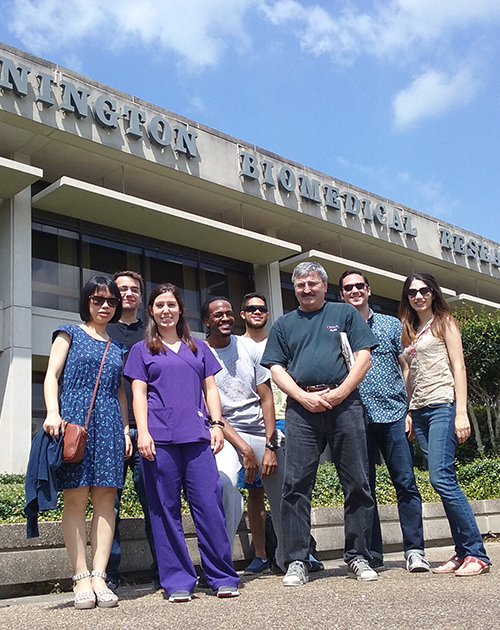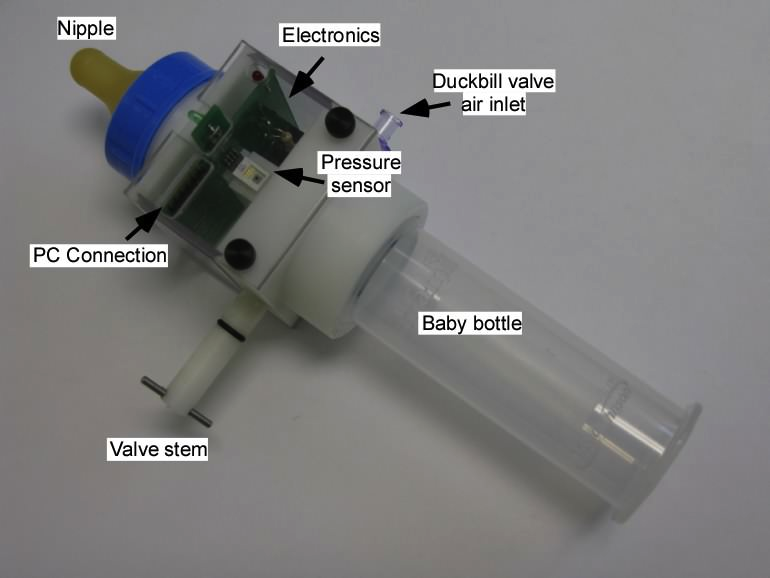The Power of Math
LSU Math Students Create a Detection Interface to Help Pennington Biomedical Researchers Measure Infant Sucking Behavior

LSU Professor of Mathematics Peter Wolenski (third from the right) and his research
team for the infant sucking behavior project.Photo Credit: April Buffington
In the summer of 2016, a group of LSU undergraduate and graduate math students developed and implemented a program in the computing environment MatLab that measured infant sucking behavior. The main idea behind this research project is that if infants aren’t properly nourished at a very early age, their brains may continue to demand more nourishment even when they don’t need it as they get older. It is conjectured that this could be a cause or at least contribute to the widespread occurrence of obesity. Abby Altazan and Dr. Leanne Redman are researchers at the Pennington Biomedical Research Center and were collecting data to test this idea. They have a novel bottle device with a pressure sensor to record the infant’s sucking behavior. But the data collection and subsequent analytic tools provided by the device’s manufacturer were seemingly unreliable and extremely complicated. They sought guidance by contacting Professor Peter Wolenski, who runs the Mathematical Consultation Clinic (MCC) in the LSU Math department.

Bottle outfitted with pressure sensor to record infant suck behavior.Photo Credit: Paige Jarreau
“They had a device that would measure an infant suck signals during bottle feeding,” Wolenski said. “But the Matlab [math software] program designed for the device was very clunky. The researchers didn’t know exactly how the analysis was working, and it didn’t appear to be working correctly or even consistently.”
Professor Wolenski had created the MCC several years ago with the goal of creating a unit on campus for creation of personalized software for various clients in collaboration with undergraduate and graduate students. Students in MATH 4020, a capstone course within the LSU Math program, are assigned a semester-long project through the clinic. When Pennington Biomedical researchers contacted Wolenski about issues with their infant suck detection device, he assigned a team of students to create a solution over the course of the summer. The project was supported by a Board of Regents grant.
“Undergraduate math majors are actually very well-equipped to analyze and organize data in ways that researchers can use it,” Wolenski said. “Research data is almost always a mathematical formulation.”
Over the summer, the group of 12 students met every day to at first brainstorm and then implement an algorithm and user interface to help Pennington Biomedical researchers collect better and more reliable data related to infant sucking behavior. Within 10 weeks, the team designed a user-friendly software tool that imports and visualizes raw data collected from a pressure sensor attached to a bottle of milk. The team created an algorithm that computes information about the way an infant sucks from a bottle, recording and interpreting for example the number of sucks and bursts of sucks, the amount of milk consumed at each suck, the duration and strength of each suck, and the interval between sucks.
Math students Abiti Adipi and Hugo Leira helped develop the mathematical theory behind the method used to measure the infant sucks, Miles Robicheaux and Zachary Bradshaw helped build the graphical user interface (GUI) programmatically, and Brandon Dellucky, Heewon Hah, Jerome Weston and Zachary Bradshaw designed and implemented the algorithm in MatLab. Amy Adair, also a Communication across the Curriculum (CxC) Distinguished Communicator candidate, was in charge of writing the weekly and final reports for the group. Other students involved in the project included Mary Wang, Margarite LaBorde and Joshua Brock.
“The major challenge of this project was that before we started creating the algorithm, there was no definition of what an infant suck is or what it looks like in terms of the data,” Sima Sobhiyeh said.
The resultant data analysis algorithm and user-friendly software tool have allowed Pennington Biomedical researchers to analyze their data at a much faster rate and more accurately than before. The LSU Math student team increased the speed of data analysis, from three minutes to run a single dataset to only three seconds to run the same dataset, by creating a clean software program that used pre-allocated memory and efficient mathematical analysis of raw data.
For Wolenski, part of the impetus for the incorporation of real-world projects into the MATH 4020 capstone course and the employment of undergraduate math students into projects taken on by the mathematical consultation clinic, such as the infant suck detection project, is to equip undergraduate math students with skills that will help them land higher-paying jobs upon graduation.
“The students love it, because they get to see how mathematics is used in the real world to describe phenomena, and they are able to learn and apply basic programming skills with MatLab,” Wolenski said.
Wolenski envisions a mathematical consultation center at LSU where researchers could come to get help with the data collection and analysis components of their research projects, while undergraduate math students gain programming and mathematical analysis skills working on real-world projects.
“The goal is to provide researchers who are struggling with data collection and data organization with programs that run quickly and accurately. That way, the researchers can focus more on their science,” Wolenski said.